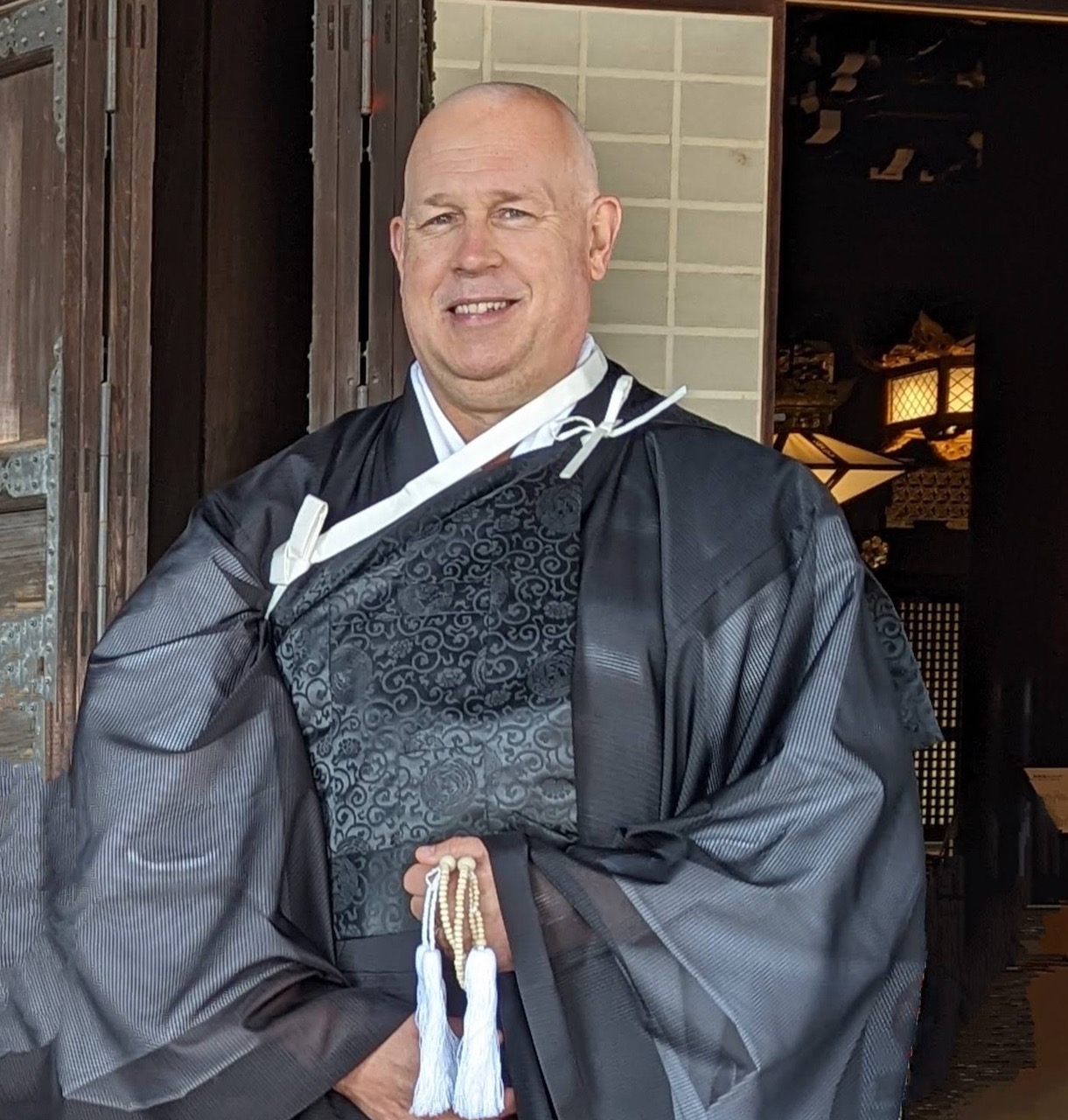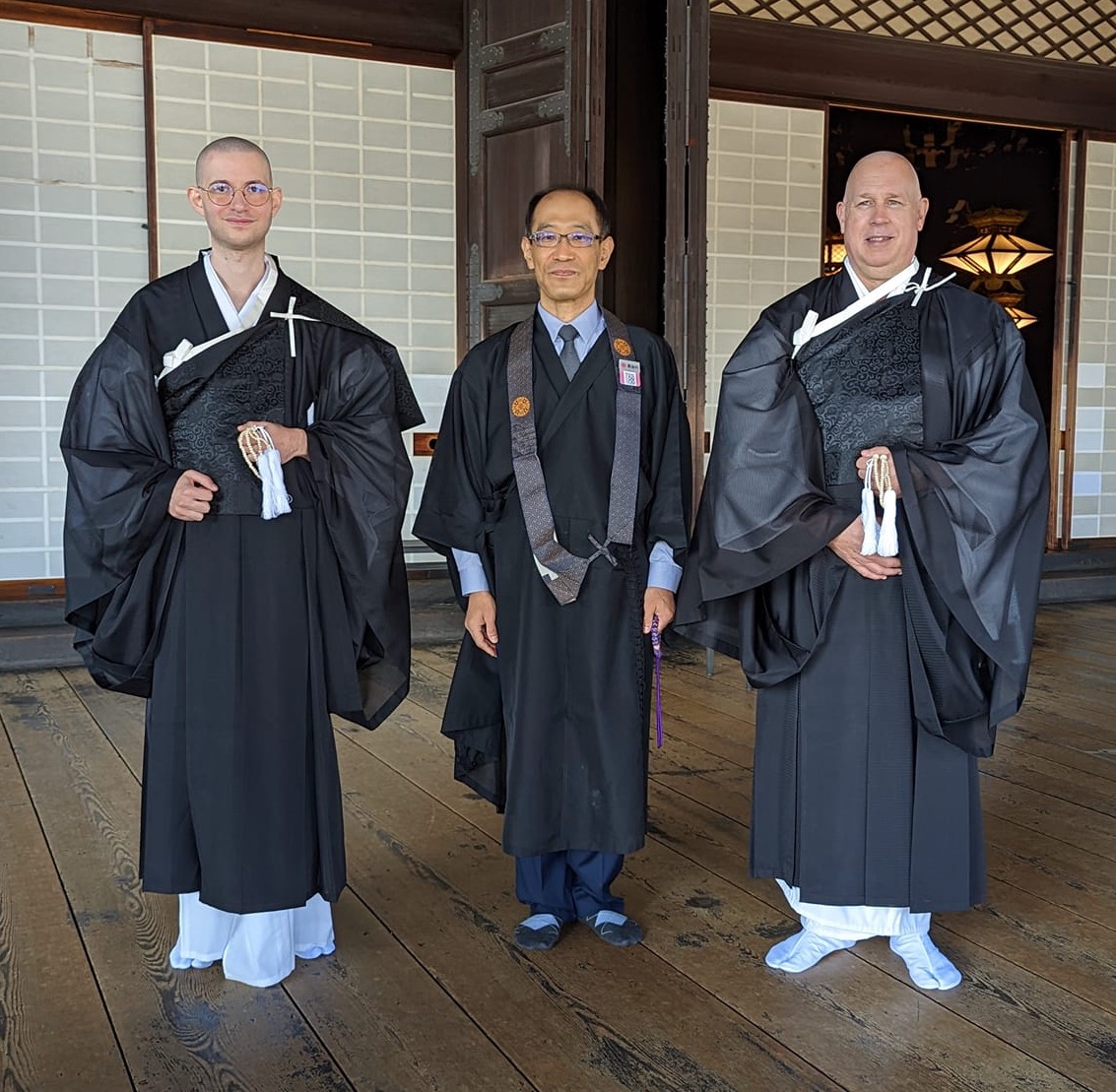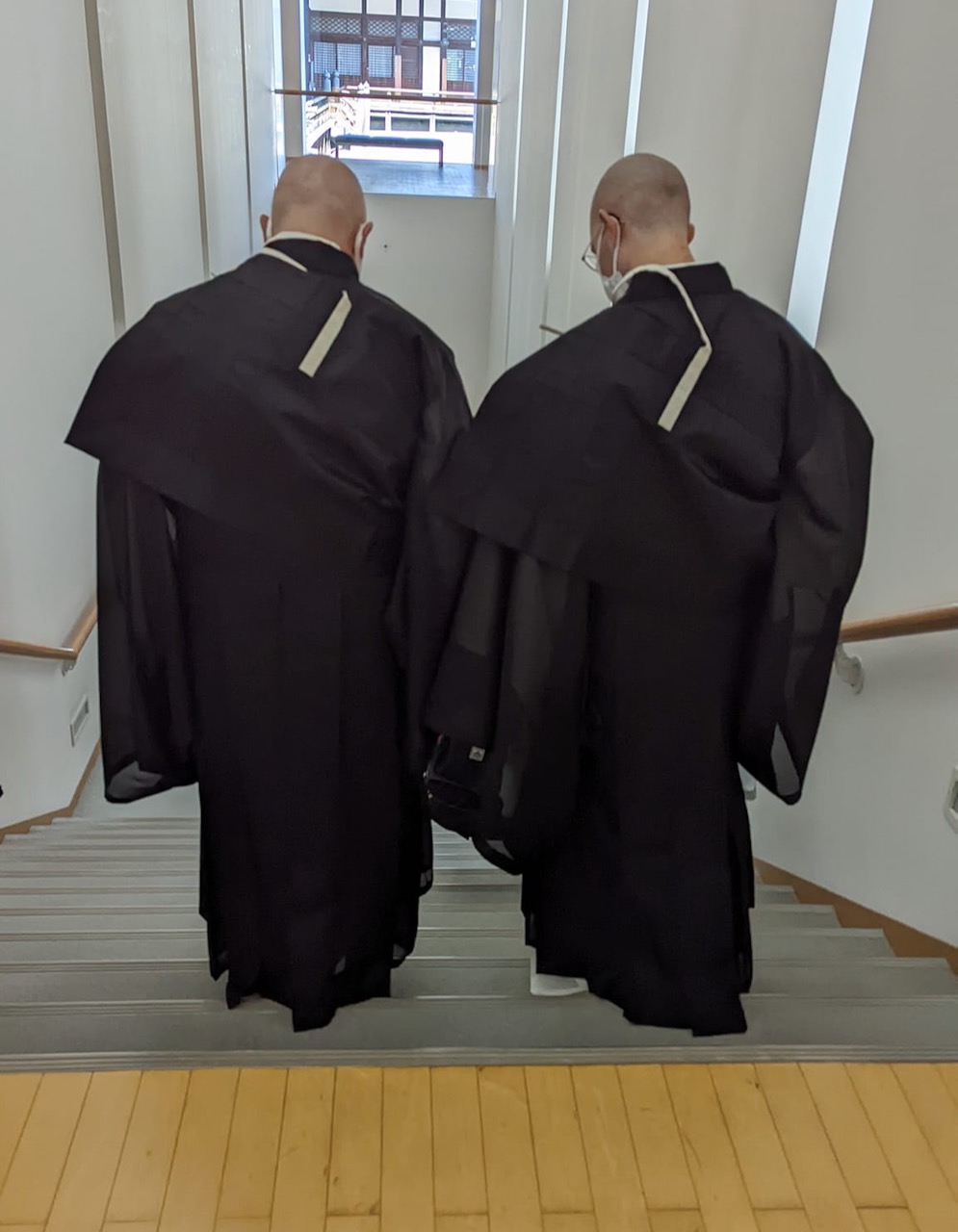
By Gary Link
I was nervous. Passing the chanting test would be a big step towards becoming an ordained Higashi Honganji priest. This journey began more than 25 years ago.
In upstate New York, I studied various Buddhist traditions, including Indian Theravada, Chinese Tien-tai, and Japanese Jodo-shu. Why now Jodo Shinshu? There’s no easy answer.
The answer, as they say, was due to many causes and conditions bringing me to this point. Bluntly speaking, I felt like a fraud. On my prior path, I asked myself, could I keep precepts? Did I try my best when meditating and chanting? Family, work, and personal responsibilities made difficult the romantic ideal I thought a Buddhist should be. In frustration, I nearly quit Buddhism.
At rock bottom, I discovered the Tannisho and Shinran Shonin’s teachings. In Chapter 2, Shinran says:
Is the nenbutsu really the seed of rebirth in the Pure Land, or is it a karmic cause for falling into the lowest hell? Of such questions I know absolutely nothing. Even if I had been deceived by my master, Honen Shonin, and were to fall into hellish torment, I would have no regrets at all! The reason is that, had I been one who was certain to attain buddhahood by striving at some other spiritual discipline, and yet fell into an infernal state through uttering the nenbutsu, I might well be justified in regretting that I had been deceived. But as I find myself totally incapable of any kind of meritorious deed, the lowest hell in any event would be my destined abode.
For years, I couldn’t understand this kind of confession. Then, I came to grips with my own limited self, filled with various delusions and defilements, including anxiety, fear, desire and depression. The brutal honesty of Shinran’s writings lifted me up, especially his struggles with following Tendai Buddhism. He eventually abandoned the monastic life on Mt. Hiei and met Honen Shonin, who became his teacher. He realized he couldn’t live up to traditional Buddhist tenets. In reading Shinran’s words, I felt a true friend on the path. That’s how I committed myself to Jodo Shinshu.
In 2019, I met Rev. Miki Nakura, a Higashi Honganji priest based in New York. We seemed to share a karmic bond. We deeply discussed Jodo Shinshu and general Buddhism.
As I studied and pondered the writings of various Jodo Shinshu teachers, I became increasingly engaged. The teachings challenged me to look deeply within myself. They made me question my own beliefs and understandings about Buddhism. Through introspection came fleeting moments of insight. My perspective changed, and with it, a fresh approach for dealing with doubts about certain doctrine and concepts. I’m grateful for the lineage of important Shinshu teachers, including Manshi Kiyozawa, Ryojin Soga, Daiei Kaneko and Yoshikiyo Hachiya.
I also studied with Professor Michael Conway, an American who teaches Shinshu studies at Otani University in Kyoto. Studying with Nakura-sensei also helped. I felt a karmic affinity with all these teachers. They continue to spur, engage, and challenge me.
My wife Heidi and I received our “Buddhist names” in a “kikyoshiki” ceremony, symbolizing our commitment to the Jodo Shinshu path and living within Amida Buddha’s Primal Vow. I told Nakura-sensei about my wish to share the Dharma with others by becoming ordained. We spoke at length regarding my reasons. He agreed the time was right to move forward.
First, I needed to pass a chanting test given by Bishop Noriaki Ito of Higashi Honganji’s North America District. A staff minister, Rev. Tomoyuki Hasegawa helped me prepare by providing chanting instruction. The exam was set for June in 2022.
The test consists of chanting “Shoshinge” and wasans (Shinran’s hymns) and Amida-kyo (Smaller Sutra on the Buddha of Infinite Life), which is relatively long. I practiced every day. Rev. Hasegawa slowed my tempo and regulated my breathing and phrasing. Chanting Higashi Honganji’s unique “mitsuryuri” style is nuanced and tricky. By contrast, Amida-kyo is fast. No way could I pull that off. Fortunately, chanting slower was permitted. I practiced sitting seiza, Japanese style, which was painful to my knees and legs.
I passed the test and was ready for the tokudo ordination ceremony in Japan. Tokudo is a first level of ordination, which allows recipients to participate in services under the supervision of a senior minister. Full ordination, called kyoshi, requires much more study and training.
In early 2022, Covid was still going strong and the opportunity to visit Japan was tenuous at best. Japan was still closed to foreigners. I received a temporary visa. Much preparation was needed for the trip, such as ensuring I had all my Covid booster shots. A month prior to my trip, Japan lifted many Covid-related restrictions, so my wife and I didn’t need a visa after all.
We arrived in Japan last November 4th. Nakura-sensei met my wife and me in Osaka and we traveled by train to Kyoto. I thought it comical our hotel had an Italian restaurant. We didn’t travel all this way to eat Italian food in Japan. Our native New York is known for Italian restaurants. The next day, we met Rev. Hasegawa, who gave us a tour of important historical sites related to Jodo Shinshu, including Shinran’s burial place.
The tokudo ceremony requires males to participate with shaven heads. At 58 years old and no longer concerned about vanity, losing my hair didn’t bother me. I was curious to see myself bald. My wife wasn’t so enthusiastic.
The barbershop Rev. Hasegawa chose was closed so we looked for another. We descended into a basement, smelled a faint odor of mold, and encountered a barber who looked in his 80s. His equipment and methods transported me back to a distant past. He shuffled along the floor holding a straight-edge razor that shook uncontrollably as it headed towards my head. Thoughts of an international incident must have weighed on Rev. Hasegawa’s mind. When the barber began shaving my head, the shaking stopped, and he became steady as a rock. All proceeded without incident.

The next day was the ceremony. Gregory Thomas from France participated with me. We both were nervous. Realizing my limitations sitting seiza, I asked for a chair and was relieved when one was provided. We wore all white robes and waited in an auditorium for instruction.
After orientation, we walked into the “Founders Hall” (Japanese: Goei-do) and received further instructions. We left the hall and put on formal black robes. We re-entered the Goei-do, the doors shut, and we waited in darkness, except for a few lighted candles. I noticed the glow of a candle behind the main altar. As I sat to the left of the main altar, I could see a scroll with an image of Rennyo Shonin. Rennyo and I stared at each other. I felt like Rennyo whispered to me, “Do your best.”
I had the honor of presenting an offering during the ceremony. It was quite magical, making me recall“Words of Rennyo” (Japanese: Goichidaiki-kikigaki), which says:
Be ready to give yourself up if it is for the sake of making one person attain shinjin. Your selfless effort will not be unrewarded.
When the ceremony ended, the doors flung open and the public was allowed to come in.
Gregory and I changed from formal robes to informal ones. Rev. Hasegawa patiently showed us how to properly fold our robes. Folding the formal robe is quite difficult and Hasegawa-sensei wanted to ensure it was done right. Although pressed for time, he was determined. Afterwards, we met Shinshu Otani-ha Abbot Choyu Otani, and his son, Overseas District Abbot Yul Otani. We spoke about our plans for the future.

After the ordination ceremony, I was exhausted. The weight of a year’s preparation fell from my shoulders and pent-up anxiety drained from my body. Later, Nakura-sensei took us to see many places and meet various people, both lay people and priests. Highlights of our tour included Kanazawa, Nara, Inami, Gokayama, Otani University, the D.T. Suzuki Museum, the Eastern Buddhist Society, and many temples.
I’m grateful for receiving tokudo. Of course everything in life is due to others. I appreciate the many people who made this experience possible for me.
Now that I’m ordained, what are my plans? Gregory and I often discussed the responsibility of being Westerners and the bar we want to set for those who might come after us. Although tokudo is only a first step, I have a deep wish to continue studying, learning, and eventually receiving full ordination. I hope a kyoshi curriculum is established in North America. I also hope to help Nakura-sensei grow the New York sangha, and possibly establish a Higashi Honganji temple there.
As I look back on my road to tokudo, I feel a great sense of gratitude. Throughout this journey, I’ve experienced exalted highs and bottomless lows. Reflecting back, the bottomless lows have been my true teachers. I’m grateful for what I’ve learned, the people I’ve met, and the strong foundation I’ve received.
-Gary Link lives in upstate New York.

